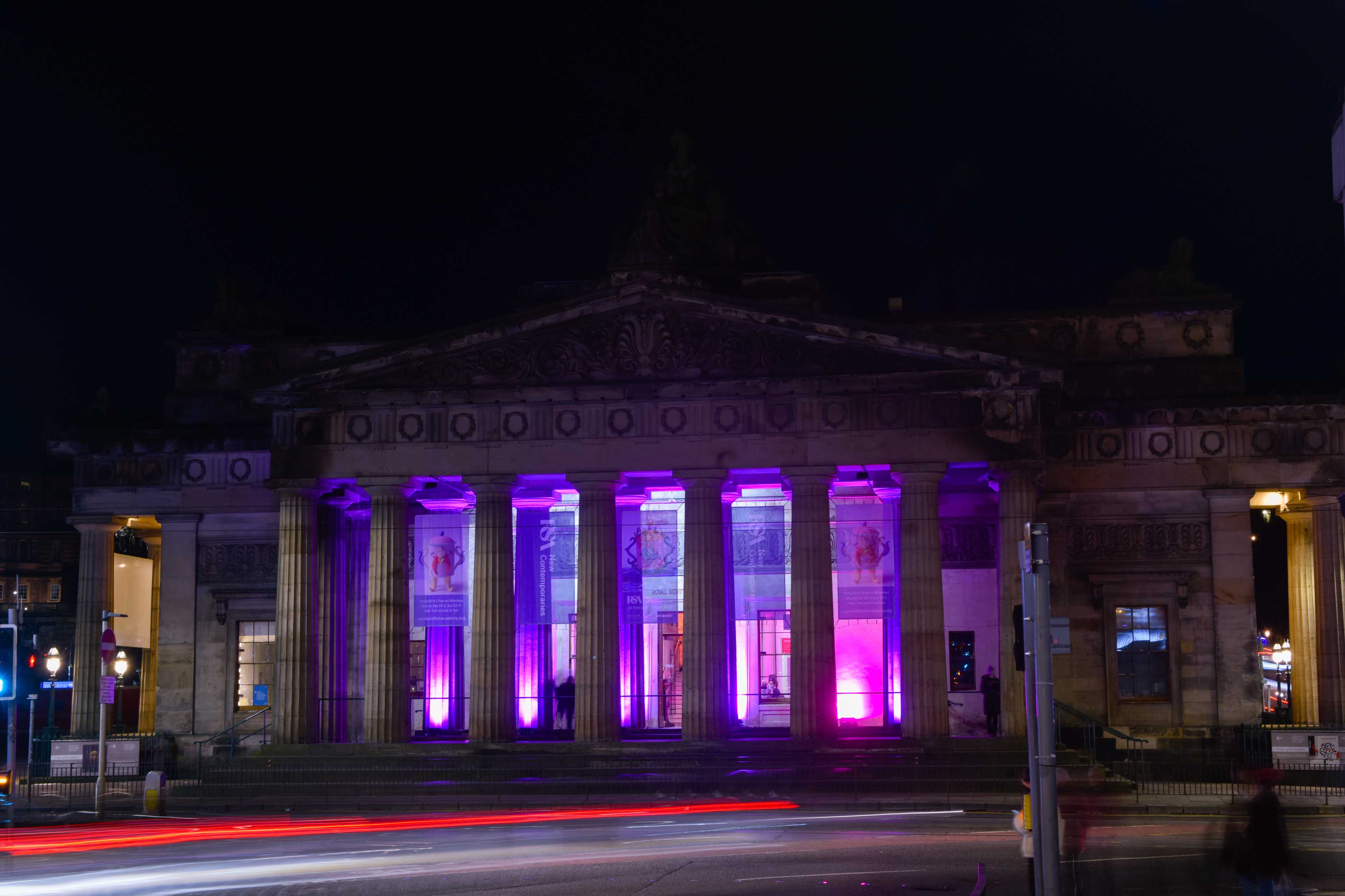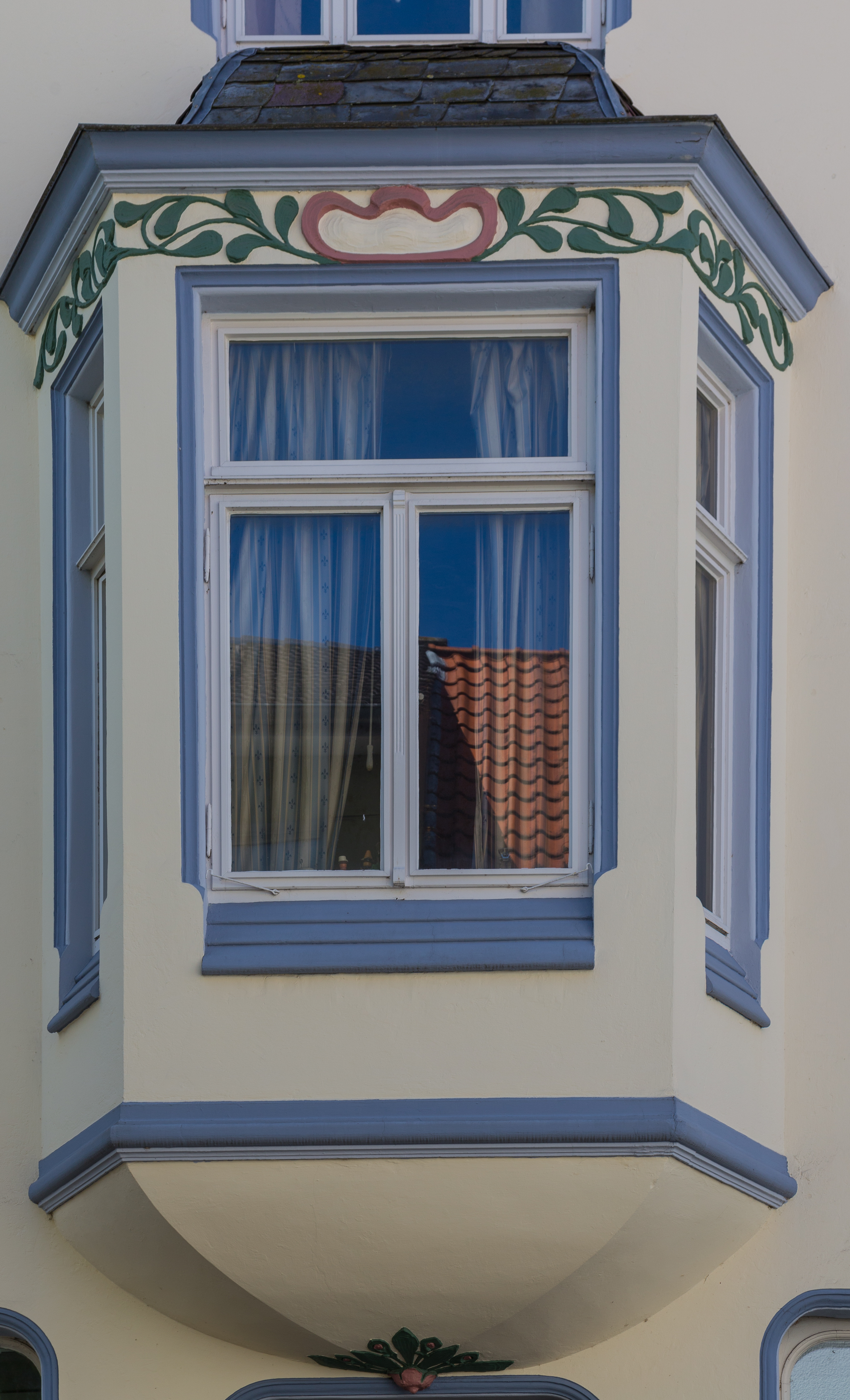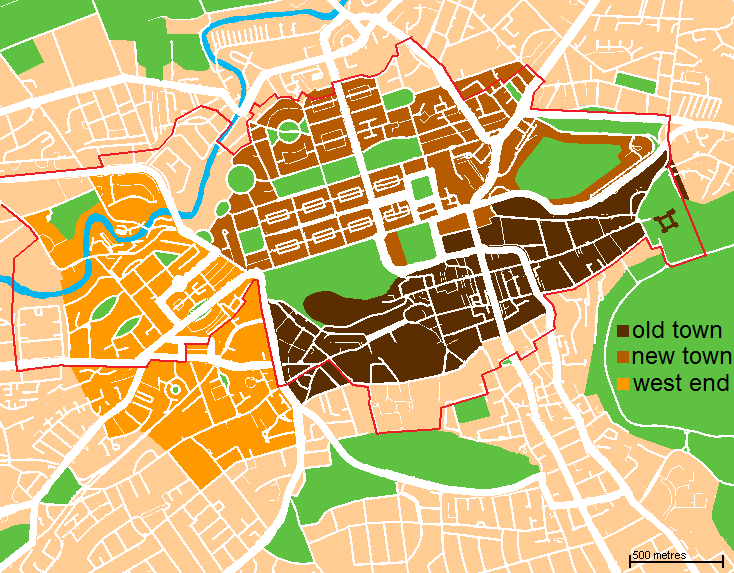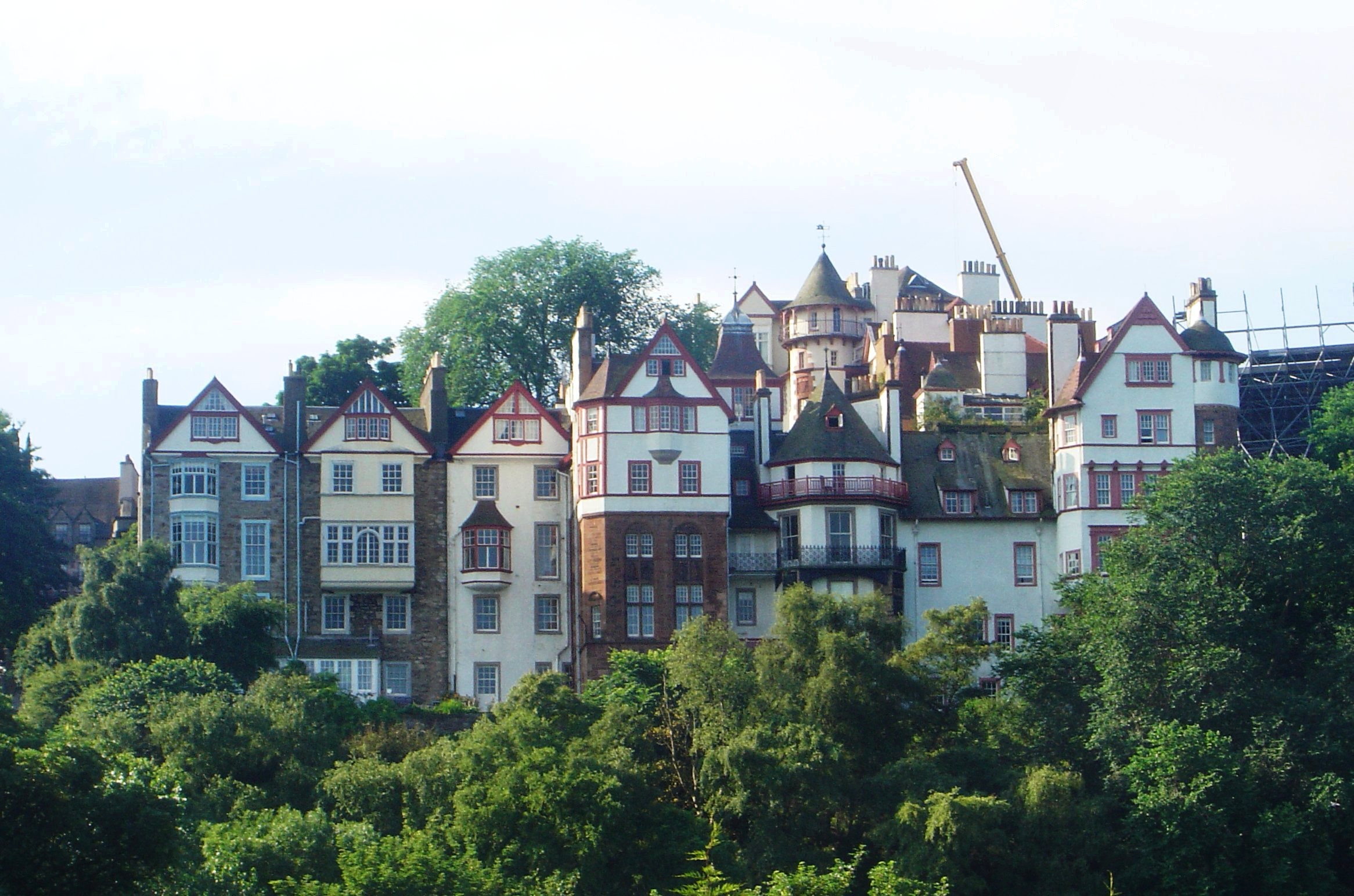|
Ramsay Garden
Ramsay Garden is a block of sixteen private apartment buildings in the Castlehill area of Edinburgh, Scotland. They stand out for their red ashlar and white harled exteriors, and for their prominent position, most visible from Princes Street. Developed into its current form between 1890 and 1893 by the biologist, botanist and urban planner Patrick Geddes, Ramsay Garden started out as Ramsay Lodge, an octagonal house built by the poet and wig-maker Allan Ramsay the Elder in 1733. The house was also known variously as Ramsay Hut and Goosepie House (due to the roof shape). It was complemented by the addition of Ramsay Street, a short row of simple Georgian Houses in 1760. The latter (in revamped form) stand on the north side of the access to the inner courtyard. History Geddes' work on Ramsay Garden began in the context of an urban renewal project that he had embarked on in Edinburgh’s Old Town. The area had fallen into disrepair, and Geddes hoped both to improve the living c ... [...More Info...] [...Related Items...] OR: [Wikipedia] [Google] [Baidu] |
Royal Mile
The Royal Mile () is the nickname of a series of streets forming the main thoroughfare of the Old Town, Edinburgh, Old Town of Edinburgh, Scotland. The term originated in the early 20th century and has since entered popular usage. The Royal Mile runs between two significant locations in the royal history of Scotland, Edinburgh Castle and Holyrood Palace, and has a total length of approximately one mile. The streets which make up the Royal Mile are (west to east) Castlehill, the Lawnmarket, the High Street, the Canongate and Abbey Strand. The Royal Mile is the busiest Tourism in Scotland, tourist street in the Old Town, rivalled only by Princes Street in the New Town, Edinburgh, New Town. The Royal Mile contains a variety of shops, restaurants, public houses, and visitor attractions. During the annual Edinburgh Festival Fringe, Edinburgh Fringe, the High Street becomes crowded with tourists, entertainers, and buskers. Parliament Square is at the heart of Scotland's legal syste ... [...More Info...] [...Related Items...] OR: [Wikipedia] [Google] [Baidu] |
Urban Renewal
Urban renewal (sometimes called urban regeneration in the United Kingdom and urban redevelopment in the United States) is a program of land redevelopment often used to address real or perceived urban decay. Urban renewal involves the clearing out of areas deemed blighted, often in inner cities, in favour of new housing, businesses, and other developments. 19th Century The concept of urban renewal as a method for social reform emerged in England as a reaction to the increasingly cramped and unsanitary conditions of the urban poor in the rapidly industrializing cities of the 19th century. The agenda that emerged was a progressive doctrine that assumed better housing conditions would reform its residents morally and economically. Modern attempts at renewal began in the late 19th century in developed nations. However, urban reform imposed by the state for reasons of aesthetics and efficiency had already begun in 1853, with Haussmann's renovation of Paris ordered by Napoleon III. T ... [...More Info...] [...Related Items...] OR: [Wikipedia] [Google] [Baidu] |
Buildings And Structures In Edinburgh
A building or edifice is an enclosed structure with a roof, walls and windows, usually standing permanently in one place, such as a house or factory. Buildings come in a variety of sizes, shapes, and functions, and have been adapted throughout history for numerous factors, from building materials available, to weather conditions, land prices, ground conditions, specific uses, prestige, and aesthetic reasons. To better understand the concept, see ''Nonbuilding structure'' for contrast. Buildings serve several societal needs – occupancy, primarily as shelter from weather, security, living space, privacy, to store belongings, and to comfortably live and work. A building as a shelter represents a physical separation of the human habitat (a place of comfort and safety) from the ''outside'' (a place that may be harsh and harmful at times). buildings have been objects or canvasses of much artistic expression. In recent years, interest in sustainable planning and building pract ... [...More Info...] [...Related Items...] OR: [Wikipedia] [Google] [Baidu] |
Royal Scottish Academy
The Royal Scottish Academy (RSA) is the country's national academy of art. It promotes contemporary art, contemporary Scottish art. The Academy was founded in 1826 by eleven artists meeting in Edinburgh. Originally named the Scottish Academy, it became the Royal Scottish Academy on being granted a royal charter in 1838. The RSA maintains a unique position in the country as an independently funded institution led by eminent artists and architects to promote and support the creation, understanding, and enjoyment of visual arts through exhibitions and related educational events. History The Royal Institution for the Encouragement of the Fine Arts in Scotland (RI) was founded in 1819 with the aim of mounting exhibitions and promoting artistic appreciation in Scotland. The RI acquired artworks by contemporary Scottish artists as well as a number of Old Master, Old Masters. A new building to house the exhibitions, the Royal Scottish Academy Building, Royal Institution designed by ... [...More Info...] [...Related Items...] OR: [Wikipedia] [Google] [Baidu] |
George Clark Stanton
George Clark Stanton RSA (11 June 1832- 8 January 1894) was a 19th-century Scottish sculptor, silversmith and portrait miniaturist. Life Stanton was educated at King Edward's School, Birmingham and Birmingham School of Art, initially training as a silversmith. In Birmingham he was employed by Elkington & Mason. Some of his work from there is now in the Victoria and Albert Museum in London. He allegedly joined Garibaldi's Redshirts during a trip to Florence, Italy. During this trip he met Clara Camgee, who later became his wife. In 1855 he moved to Edinburgh, living first at 21 Dublin Street then at 1 Ramsay Lane. He also lived at 24 (now 38) Upper Gray Street. In 1862 he was elected an associate of the Royal Scottish Academy and in 1885 became a full member. From 1879 he was Curator of the Royal Scottish Academy Life School. He lived his final years at Ramsay Lane (part of Ramsay Gardens). His son, John George Stanton, was also an artist.u Known works * "Army and N ... [...More Info...] [...Related Items...] OR: [Wikipedia] [Google] [Baidu] |
Commercial Bank Of Scotland
The Commercial Bank of Scotland Ltd. was a Scotland, Scottish commercial bank. It was founded in Edinburgh in 1810, and obtained a royal charter in 1831. It grew substantially through the 19th and early 20th centuries, until 1958, when it merged with the National Bank of Scotland to become the National Commercial Bank of Scotland. Ten years later the National Commercial Bank merged with the Royal Bank of Scotland. History Formation The Commercial Bank of Scotland was formed in 1810 in response to public dissatisfaction with the three charter banks (Bank of Scotland, British Linen Bank and The Royal Bank of Scotland): "it was felt by many of the Scottish people that the three old Banks had become too…devoted to their own interests…to be the real promoters of the general good."James Anderson, ''The Story of the Commercial Bank of Scotland'' (1910) Checkland argued that the project was "without precedent" for the proposed joint stock company relied not on a restricted group o ... [...More Info...] [...Related Items...] OR: [Wikipedia] [Google] [Baidu] |
Charles Mackie (artist)
Charles Mackie may refer to: * Charles Mackie (Scottish footballer) (1882–?), played in England and Scotland * Charles Mackie (New Zealand footballer) (fl. 1936), played once for New Zealand * Charles Mackie (sport shooter) (1885–?), British sport shooter * Charles Hodge Mackie (1862–1920), British artist {{hndis, Mackie, Charles ... [...More Info...] [...Related Items...] OR: [Wikipedia] [Google] [Baidu] |
Fresco
Fresco ( or frescoes) is a technique of mural painting executed upon freshly laid ("wet") lime plaster. Water is used as the vehicle for the dry-powder pigment to merge with the plaster, and with the setting of the plaster, the painting becomes an integral part of the wall. The word ''fresco'' () is derived from the Italian adjective ''fresco'' meaning "fresh", and may thus be contrasted with fresco-secco or secco mural painting techniques, which are applied to dried plaster, to supplement painting in fresco. The fresco technique has been employed since antiquity and is closely associated with Italian Renaissance painting. The word ''fresco'' is commonly and inaccurately used in English to refer to any wall painting regardless of the plaster technology or binding medium. This, in part, contributes to a misconception that the most geographically and temporally common wall painting technology was the painting into wet lime plaster. Even in apparently '' buon fresco'' technology ... [...More Info...] [...Related Items...] OR: [Wikipedia] [Google] [Baidu] |
Bay Window
A bay window is a window space projecting outward from the main walls of a building and forming a bay in a room. A bow window is a form of bay with a curve rather than angular facets; an oriel window is a bay window that does not touch the ground. A window may be all three: projecting outward from the main fascia of a wall, curved in shape, and not reaching the ground. A bay window may be supported from the ground by a foundation, or in space by corbels, brackets, or cantilever. A typical bay window consists of a central windowpane, called a fixed sash, flanked by two or more smaller windows, known as casement or double-hung windows. The arrangement creates a panoramic view of the outside, allows more natural light to enter the room, and provides additional space within the room. Bay windows are often designed to extend beyond the exterior wall, either adding to floor space, often filled with a table, desk, or seating area, or turned into a window seat (often with storage o ... [...More Info...] [...Related Items...] OR: [Wikipedia] [Google] [Baidu] |
Old Town, Edinburgh
The Old Town () is the oldest part of Scotland's capital city of Edinburgh. The area has preserved much of its medieval street plan and many Scottish Reformation, Reformation-era buildings. Together with the 18th/19th-century New Town, Edinburgh, New Town, and West End, Edinburgh, West End, it forms part of a protected UNESCO World Heritage Site. Royal Mile The "Royal Mile" is a name coined in the early 20th century for the main street of the Old Town which runs on a downwards slope from Edinburgh Castle to Holyrood Palace and the ruined Holyrood Abbey. Narrow ''List of closes on the Royal Mile, closes'' (alleyways), often no more than a few feet wide, lead steeply downhill to both north and south of the main spine which runs west to east. Significant buildings in the Old Town include St. Giles' Cathedral, the General Assembly Hall of the Church of Scotland, the National Museum of Scotland, the Old College, University of Edinburgh, Old College of the University of Edinburgh, P ... [...More Info...] [...Related Items...] OR: [Wikipedia] [Google] [Baidu] |
Allan Ramsay (poet)
Allan Ramsay (15 October 16867 January 1758) was a Scottish poet (or ''makar''), playwright, publisher, librarian and impresario of early Scottish Enlightenment, Enlightenment Edinburgh. Ramsay's influence extended to England, foreshadowing the reaction that followed the publication of ''Percy's Reliques''. He was on close terms with the leading Intellectual#Man of Letters, men of letters in Scotland and England. He corresponded with William Hamilton (Jacobite poet), William Hamilton of Bangour, William Somervile, John Gay and Alexander Pope. He began writing poetry as a member of the Easy Club and in 1715 became Club Laureate. Ramsay published verses and turned bookseller in 1718, selling poetry collections like ''Wealth and the Woody'', a satire on the South Sea Company. In 1720, he collected and published his poems, establishing a circulating library in 1726. Ramsay edited ''The Tea-Table Miscellany'' and ''The Ever Green'' and is considered as a pastoral writer and editor who ... [...More Info...] [...Related Items...] OR: [Wikipedia] [Google] [Baidu] |
Stewart Henbest Capper
Stewart Henbest Capper (15 December 1859 – 8 January 1925) was a prominent architect in the Arts and Crafts style closely associated with Sir Patrick Geddes with much of his work mislabelled as Geddes'. Due to ill health he did not achieve much that he might have, and his contemporary Sydney Mitchell completed much of his most public works. His style cleverly mimics medieval and Renaissance details, and, as it sometimes includes either original or faked medieval date-stones, is regularly accepted as being several centuries older than its true age. In later life he is remembered as Professor Capper due to his academic role at McGill University in Canada. This is often remembered more than for his work in Scotland, and much of his due fame has been laid on the shoulders of his clients and those who completed his works. Early life Born in Douglas, Isle of Man, the son of Jasper John Capper (1820–1918), he was raised in Upper Clapton in London until his family moved to Ed ... [...More Info...] [...Related Items...] OR: [Wikipedia] [Google] [Baidu] |







